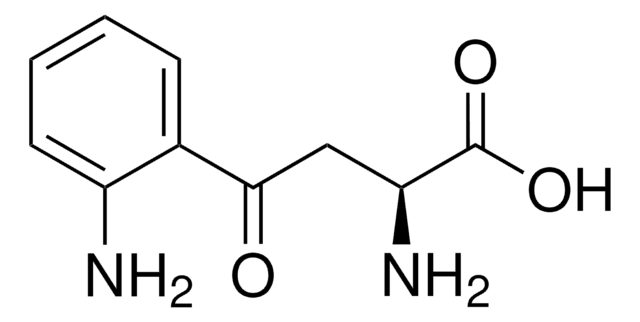SML0096
Cinnabarinic Acid
≥98% (HPLC)
Synonym(s):
2-amino-3-oxo-3H-phenoxazine-1,9-dicarboxylic acid, Cinnabaric acid
About This Item
Recommended Products
Quality Level
Assay
≥98% (HPLC)
form
powder
storage condition
desiccated
color
red to very dark red
solubility
DMSO: ≥4 mg/mL
storage temp.
2-8°C
SMILES string
NC1=C(C(O)=O)C2=Nc3c(OC2=CC1=O)cccc3C(O)=O
InChI
1S/C14H8N2O6/c15-10-6(17)4-8-12(9(10)14(20)21)16-11-5(13(18)19)2-1-3-7(11)22-8/h1-4H,15H2,(H,18,19)(H,20,21)
InChI key
FSBKJYLVDRVPTK-UHFFFAOYSA-N
Application
Biochem/physiol Actions
Cinnabarinic acid (CA) connects between initiation of the kynurenine pathway and immune tolerance that is used to prevent neuroinflammation.
Features and Benefits
Storage Class Code
11 - Combustible Solids
WGK
WGK 3
Flash Point(F)
Not applicable
Flash Point(C)
Not applicable
Certificates of Analysis (COA)
Search for Certificates of Analysis (COA) by entering the products Lot/Batch Number. Lot and Batch Numbers can be found on a product’s label following the words ‘Lot’ or ‘Batch’.
Already Own This Product?
Find documentation for the products that you have recently purchased in the Document Library.
Related Content
Apoptosis, or programmed cell death (PCD), is a selective process for the removal of unnecessary, infected or transformed cells in various biological systems. As it plays a role in the homeostasis of multicellular organisms, apoptosis is tightly regulated through two principal pathways by a number of regulatory and effector molecules.
Our team of scientists has experience in all areas of research including Life Science, Material Science, Chemical Synthesis, Chromatography, Analytical and many others.
Contact Technical Service







